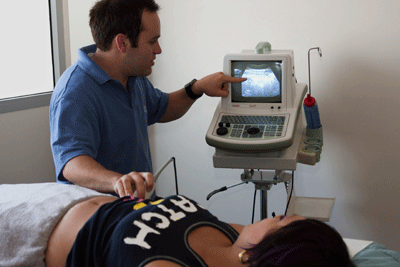Real Time Ultrasound
See the difference
Real time ultrasound (RTUS) or sonography works by transmitting sound waves through the body. Those sound waves are then reflected off the internal body organs and the machine is able to create an image of the different muscles and organs of the body.

Physiotherapists at Sport & Spinal Physiotherapy have embraced ultrasound imaging in response to recent research which reveals that the primary impairment of the muscular system in individuals with low back pain is not one of strength or functional capacity but rather one of motor control of the deep muscles of the abdomen, lower back and pelvic floor. These muscles work together to help form a cylinder of stability around your trunk, just like a corset. If these core muscles are working correctly they will provide support for your spine, pelvis and lower limbs to function. However, an injury or trauma can damage this system and cause weakness or inhibition in these muscles. Unfortunately, these important muscles do not return to normal if no specific retraining is conducted leading to chronic or recurrent injuries. RTUS helps eliminate the guesswork in dynamic core stability training, meaning we fix your problem faster with less chance of reoccurrence.
When do we use ultrasound imaging?
Physios at Sport & Spinal Physiotherapy use real time ultrasound imaging to help clients from Gungahlin, Canberra City, and the wider Canberra community for:-
- Low back pain
- Sacroiliac joint pain and dysfunction
- Pelvic pain and instability
- Osteitis pubis
- Hip pain
- Gluteal pain
- Chronic hamstring strains
- Disc replacement
- Post abdominal surgery rehabilitation
- Post spinal & pelvic surgery
- Pregnancy pain
- Post childbirth pain
- Incontinence
- Pelvic floor retraining
- Sciatica
- Pre-exercise programs
- lower abdominal bulging
- Sports injuries
- Lower limb injuries
- Workplace injuries
See your actual muscles working
We use our state-of-the-art ultrasound machine to give you a moving image of your core muscles. Through the ultrasound, you can receive important feedback for correct activation of these muscles. The ultrasound will allow real time study of these deep muscles so your therapist can devise the right plan of action. With the help of ultrasound, you will actually be able to watch the inner muscles contracting during exercise.
Core benefits of real time ultrasound imaging
- Accurate assessment tool and feedback of core muscle activation
- Correct activation of your core stability muscles
- Helps to better understand the functioning and requirements of the stabilising system
- Reduces risk of recurrent injury
- Significantly improves recovery time
- Quick return of normal function
What to expect
The process is simple and painless. You will be required to wear loose fitting clothing in order to adequately expose your deep core muscles. A reasonably full bladder will help in the assessment of any pelvic floor muscle dysfunction. Your initial RTUS session is FREE. Generally, it takes 4 to 6 sessions of retraining with RTUS to achieve adequate core stability. Once this has been achieved, we will advise you of the most appropriate exercises to maintain your core stability.
Ultrasound imaging and gym rehabilitation
Gym rehabilitation is made more effective with ultrasound imaging. You get the foundations right with core stability retraining with RTUS and then build your strength around this with a membership to our gymnasium.
Research
Ultrasound (US) Retraining has been shown to have a 70% success rate preventing a return of low back pain (LBP) within 12 months. The same study showed that those patients who didn’t undergo the ultrasound retraining had only a 16% chance of remaining painfree. This means your chance of avoiding repeat back pain is 4.4 times better with US Retraining.
Research has also shown that that 65% of back pain sufferers didn’t have another bout of pain within three years after undertaking US Retraining. This means the treatment also endures the test of time.
Unfortunately, spinal manipulative therapy (eg chiropractic treatment) without an exercise program does not stimulate your deep core muscles. You still need specific muscle retraining, made all the easier with RTUS. (Ferreira et al 2007)
If you have had a recent or chronic back injury, have under gone abdominal surgery, given birth or would just like to avoid future injury you may benefit from an assessment of your core stability with Sport & Spinal Physiotherapy using real time ultrasound imaging.

